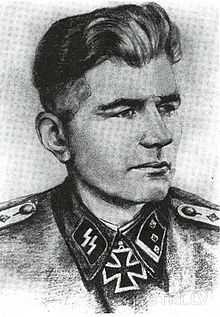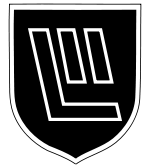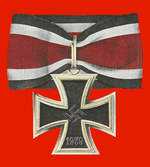Miervaldis Adamsons
| Miervaldis Adamsons | |
|---|---|
 Portrait of Miervaldis Ādamsons | |
| Nickname(s) | The Moroccan Terror |
| Born |
29 June 1910 Poltava, Russian Empire Now Ukraine |
| Died |
23 August 1946 (aged 36) Riga, Latvian SSR Now Latvia |
| Allegiance |
|
| Service/branch |
|
| Years of service |
1929–1936 1936–1939 1942–1945 |
| Rank | Hauptsturmführer |
| Unit |
|
| Commands held | 6th Company, 44th Waffen Grenadier Regiment |
| Battles/wars | World War II |
| Awards | Knight's Cross of the Iron Cross |
Miervaldis Adamsons (Latvian: Miervaldis Ādamsons) (29 June 1910 – 23 August 1946) Latvian military officer who during World War II Joined the Waffen SS and got the rank of Hauptsturmführer. He was awarded the Knight's Cross of the Iron Cross, which was awarded to recognize extreme battlefield bravery or successful military leadership by Nazi Germany during World War II.
Early life
Miervaldis Adamsons was born on 29 June 1910, in Poltava. In the 1920s his family returned to Latvia and settled in Cēsis where Miervaldis graduated city gymnasium. In 1928, Miervaldis started theology studies at the University of Latvia. In this period he became a member of the oldest Latvian student fraternity, Lettonia. However soon he left his studies and joined the Merchant navy. During his travels he wisited Africa and South America however due to his sharp character he often got into trouble and finally after a conflict with ship captain he landed in Marsailles, France and joined the French Foreign Legion signing a six year contract in 1930. There he served in Morocco in cavalry units and was many times decorated for bravery. There he earned the nickname The Moroccan Terror and was promoted to be an NCO.[1]
After his service in the Foreign Legion he returned to Latvia and joined the Latvian Army in 1937 serving as an officer in the 8th Daugavpils Infantry Regiment.[1]
World War II
The Latvian Army was disbanded under the occupation of the Soviet Union. When the Germans invaded in Operation Barbarossa in June 1941, Ādamsons was leading a partisan unit in Vidzeme which was involved in skirmishes with retreating Red Army. Later he voluntarily joined the 26th Tukums Battalion and by June 1942 was stationed in the Minsk region - now being involved in operations against Partisans on the opposite side to those he had conducted himself.
In February 1943 Ādamsons was leading a patrol over the frozen Ilmen Lake behind the Red Army's lines. They managed to destroy a soviet ammunition depot and capture a soviet officer.
In April 1943, Adamson was in the 2nd Battalion, Latvian Brigade on the Leningrad front and took part in the Battle of Wolchow where he was severely wounded in the head and eye. He was also awarded the Iron Cross for bravery.[1]
After recovering from his wounds he was given command of the 6th Company, 44th Waffen Grenadier Regiment, 19th Waffen Grenadier Division of the SS (2nd Latvian) which had been formed from the Latvian Brigade. He was again wounded in August 1944 just before being promoted to Hauptsturmführer in September 1944.[1]
Returning to the front he was involved in the battle of the Kurland Pocket in December 1944 and was again seriously wounded and partly lost his eyesight. His company in a single 24-hour period repelled seven attacks by the Russians, and after the battle the bodies of 400 fallen Russian soldiers could be counted in front of the Latvians positions. So fierce was the fighting the Russian 100th Army Corps was completely destroyed.[1]
For this remarkable defensive success Adamsons was awarded the Knights Cross in January 1945. Spring of the 1945 he spend in various military hospitals in Courland. During the last days of the Courland Pocket, some of Ādamsons' comrades offered him a place in a boat to Sweden, the destination of many other Latvian soldiers and civilians. He, however, refused to leave Latvia.
Post war
Ādamsons survived the war and while in Hospital he entered Soviet captivity in May 1945. At first he claimed to be a German and was sent to the prisoner of war camp in the Šiauliai but later he was sent to work in the nickel mines at Murmansk. After few months he together with several German officers tried to escape to Finland in the winter of 1945/46. However they were recaptured near the Finnish border. He was sentenced to death for homeland betrayal in May 1946 after it became clear that he is actually Latvian.[1][2]
Miervaldis Adamsons was executed in Riga on 23 August 1946 by firing squad.[1] In 1993 Ādamsons was fully exonerated by Latvian supreme court.
Miscellaneous
The Latvian Legion's attachment to the SS, unit designations and ranks were considered a formality. Latvian and Estonian soldiers regardless of whether they volunteered or were drafted, were not members of the Nazi party.
In 1949-50, United States Displaced Persons Commission investigated the Estonian and Latvian "SS" and found these military units to be neither criminal nor Nazi collaborators. On 12 September 1950, Harry N. Rosenfield, the United Nations Refugee Relief Association commissioner, wrote to Jūlijs Feldmanis, Latvia's chargé d'affaires in Washington, saying that «the Waffen-SS units of the Baltic States (the Baltic Legions) are to be seen as units that stood apart and were different from the German SS in terms of goals, ideologies, operations and constitution, and the Commission does not, therefore, consider them to be a movement that is hostile to the government of the United States under Section 13 of the Displaced Persons Act, as amended.»[3]
Awards
- Iron Cross (1939)
- Close Combat Clasp in Bronze (25 August 1944)
- Infantry Assault Badge (14 October 1944)
- Wound Badge (1939)
- in Black (15 September 1943)
- in Silver (12 April 1944)
- in Gold (1 September 1944)
- Cuff title Kurland
- Knight's Cross of the Iron Cross on 25 January 1945 as SS-Untersturmführer and chief of the 6./Waffen Grenadier-Regiment 44 (lettische Nr. 6) der SS[5][6]
References
- Citations
- ↑ 1.0 1.1 1.2 1.3 1.4 1.5 1.6 "Ritterkreuzträger Miervaldis Adamsons". Ritterkreuzträger 1939–45. Retrieved 22 April 2014.
- ↑ http://gulags.wordpress.com/2009/04/18/%C2%ABdivpadsmit-viri-uz-mirona-lades%C2%BB/
- ↑ http://www.hot.ee/vaikal/usa.htm
- ↑ 4.0 4.1 Thomas & Wegmann 1987, p. 19.
- ↑ Fellgiebel 2000, p. 113.
- ↑ Scherzer 2007, p. 188.
- Bibliography
- Henschler, Henri. & Fay, Will. (2003). Armor Battles of the Waffen-SS 1943-45. Stackpole Books. ISBN 0-8117-2905-2
- Fellgiebel, Walther-Peer (2000). Die Träger des Ritterkreuzes des Eisernen Kreuzes 1939–1945 – Die Inhaber der höchsten Auszeichnung des Zweiten Weltkrieges aller Wehrmachtteile [The Bearers of the Knight's Cross of the Iron Cross 1939–1945 — The Owners of the Highest Award of the Second World War of all Wehrmacht Branches] (in German). Friedberg, Germany: Podzun-Pallas. ISBN 978-3-7909-0284-6.
- Krätschmer, Ernst-Günther (1999). Die Ritterkreuzträger der Waffen-SS [The Knight's Cross Bearers of the Waffen-SS]. Coburg, Germany: Nation Europa Verlag. ISBN 978-3-920677-43-9.
- Mitcham Jr., Samuel. (2007). Retreat to the Reich. Stackpole Books. ISBN 0-8117-3384-X.
- Mitcham, Samuel. (2007). The German Defeat in the East, 1944-45. Stackpole Books. ISBN 0-8117-3371-8.
- Scherzer, Veit (2007). Die Ritterkreuzträger 1939–1945 Die Inhaber des Ritterkreuzes des Eisernen Kreuzes 1939 von Heer, Luftwaffe, Kriegsmarine, Waffen-SS, Volkssturm sowie mit Deutschland verbündeter Streitkräfte nach den Unterlagen des Bundesarchives [The Knight's Cross Bearers 1939–1945 The Holders of the Knight's Cross of the Iron Cross 1939 by Army, Air Force, Navy, Waffen-SS, Volkssturm and Allied Forces with Germany According to the Documents of the Federal Archives] (in German). Jena, Germany: Scherzers Miltaer-Verlag. ISBN 978-3-938845-17-2.
- Thomas, Franz; Wegmann, Günter (1987). Die Ritterkreuzträger der Deutschen Wehrmacht 1939–1945 Teil III: Infanterie Band 1: A–Be [The Knight's Cross Bearers of the German Wehrmacht 1939–1945 Part III: Infantry Volume 1: A–Be] (in German). Osnabrück, Germany: Biblio-Verlag. ISBN 978-3-7648-1153-2.
| ||||||||||||||||||||||||||||
| ||||||||||


